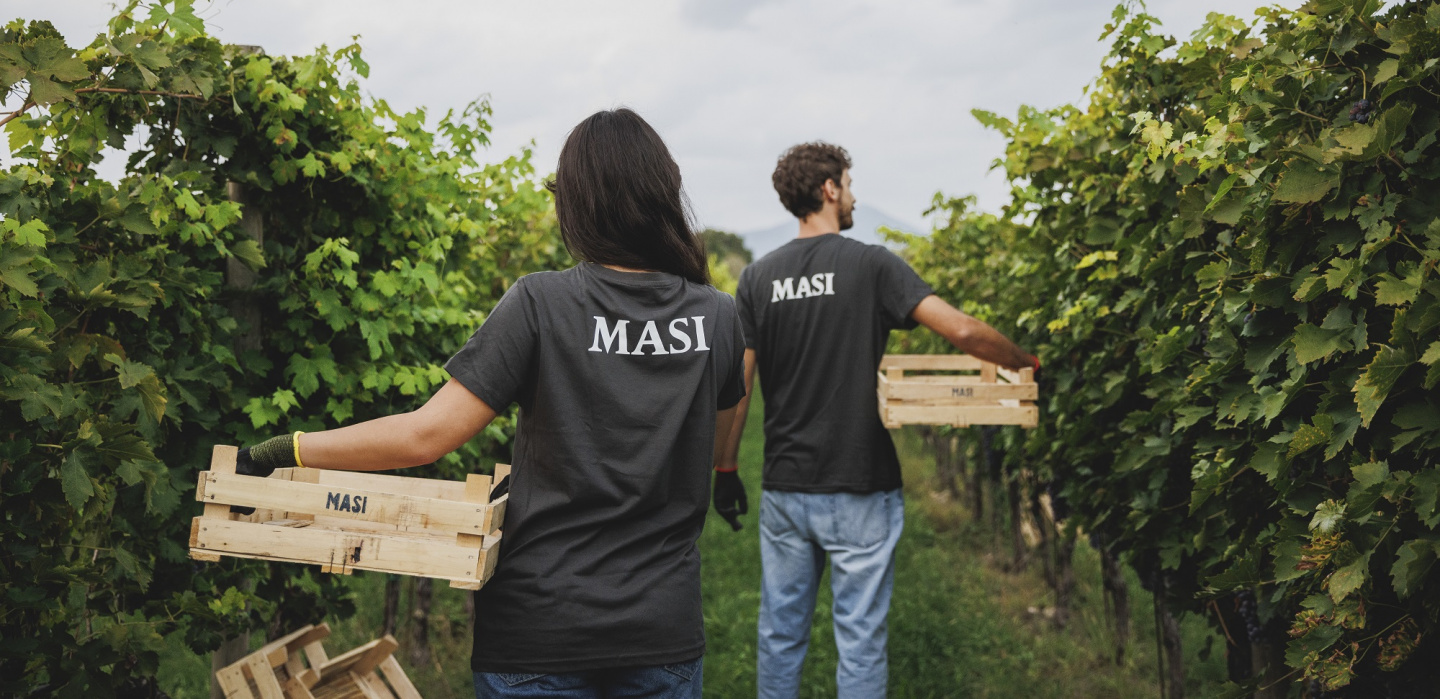Mixed results for a meteorologically problematic and anomalous vintage.
The land of Amarone is an "island of good news”
After a successful harvest last March in Argentina's Tupungato vineyards, Masi Agricola kicked off the 2023 harvest in its vineyards in the Veneto and Tuscany just a few days ago. The first grapes harvested are the early-ripening varieties in Trentino, Veneto and Friuli.
The Masi Technical Group's notes from the vineyard record the general trend for the 2023 vintage in northern and central Italy: a mild winter with little rain, a spring with above average temperatures until May, which was a month with particularly heavy rainfall, and a subsequent recovery in the growing process 5-10 days earlier than in 2022. Unstable weather in the late spring/early summer put the clock back again and resulted in slight delays in development. The long period of summer rains contributed to luxuriant development in the plants and the fruit, but also led to fungal attacks and attacks of esca disease on the most sensitive varieties. At the same time, large areas were hit by major hailstorms. The abnormal temperatures in August slowed down the metabolic activity of vines, which was already compromised in vineyards affected by hailstorms. The result is a delay of 6/7 days on average in ripening compared to 2022.
"In winemaking operations, this year more than ever, collaborative work by vignerons and winemakers will be required to cope with difficulties and anomalies. Harvesting decisions will be extremely important and the different conditions of the grapes will have to be taken into account in the cellars," comments Sandro Boscaini, Masi’s President, known by all as Mister Amarone. "Masi is a specialist in Amarone and Appassimento wines, so it is very fortunate that the Valpolicella Classica district has so far remained an “island of good news”, also from a meteorological point of view. So I dare to hope that the harvesting period will proceed in an untroubled and regular manner."
MASI SITES IN THE VENETIAN REGIONS AND TUSCANY
Veneto - Valpolicella: Valpolicella Classica is so far an “island of good news”: there has been no widespread damage from excessive rain or hail, ripening is proceeding regularly, and the grape bunches are healthy and uniform in character. In both the Serego Alighieri vineyards at Gargagnago and the legendary Vaio Armaron, as well as in Campofiorin, the harvest will begin around mid-September, followed by the medium-to-high hillside harvests in the premium Amarone vineyards: Mazzano, Campolongo di Torbe and Vaio di Masi, plus the vineyards used to make Costasera. Quantities are estimated to be slightly higher than the historical average, but still in line with regulatory norms.
Veneto - Lake Garda: Sadly, the vineyards of Tenuta Canova at Lazise suffered from a hailstorm at the end of July with a consequent loss in quantity, but fortunately not in quality; in fact, the grapes recovered well in a short time thanks to favourable weather conditions. Harvesting of Corvina, Rondinella and Corvinone grapes is planned for mid-September. In the organically managed vineyard at Rivoli, both the Corvina and Merlot grapes destined for Fresco di Masi are ripening well.
Veneto - Soave: The summer rains together with the typical breezes of the hillside vineyards producing Levarie Soave Classico have helped the vines, in particular the younger plants. In the organically-managed Colbaraca vineyard, the grapes are in excellent health and well-spaced in their bunches. Harvesting is scheduled for mid-September.
Veneto - Lugana: Unfortunately, hailstorms have affected the production of this denomination, which is particularly popular in various markets. The vineyards where Lunatio and Beldosso are produced are no exception; so quantities will be reduced and the grapes will have to be rigorously sorted.
Veneto - Valdobbiadene: The vineyards of Tenuta Canevel, where Setàge is produced, were affected by hailstorms at the end of July, leading to a slight delay in ripening. Dry weather in August allowed the damage to the grapes to heal over. There was a slight drop in production, but without compromising the quality of the harvest; this also applies to the Terre del Faé and Campofalco crus.
Trentino - Rovereto: At the Conti Bossi Fedrigotti estate, the harvest began immediately after the Ferragosto week with the grapes for Conte Federico Trento DOC Riserva: analysis shows a good wine with very good acidity. The same is true for the Pian del Griso Pinot Grigio. Harvesting of the red grapes used for Fojaneghe, Teroldego and Marzemino will begin in the second week of September.
Friuli - Castrion di Strada: Harvesting began on 24 August with the Pinot Grigio grapes for Masianco, followed by the other white varieties, and then the red ones. Slightly lower than average quantities are predicted, because of hailstorms in July. However, the grapes are well balanced with good levels of sugar and phenols.
Tuscany: The Poderi del Bello Ovile estate in Val D'Orcia has been cultivated organically for years. Heavy rainfall and the difficulty of immediate intervention in the vineyard led to widespread attacks of downy mildew. Quantities will be limited and grapes will have to be rigorously sorted. Consequently, final quantities are predicted to be less than usual.


